We interview riding expert Mike Abbott to hear his top tips
Every biker has a brown trouser moment: that scary point in time when, through error, fatigue, distraction, bravado or pure lack of experience, something goes wrong in the blink of an eye.
It could be when you entered a corner too fast for the conditions, or when a bend ‘suddenly’ turned out to be much tighter than anticipated. Or when you braked too late or accelerated too hard out of a bend. The list is endless.
‘BTMs’ often strike early in your riding career but can happen at any time and – usually – they’re a wake-up call, reminding you to take more care, leaving you with nothing worse than a racing pulse, dented pride and a cold sweat.
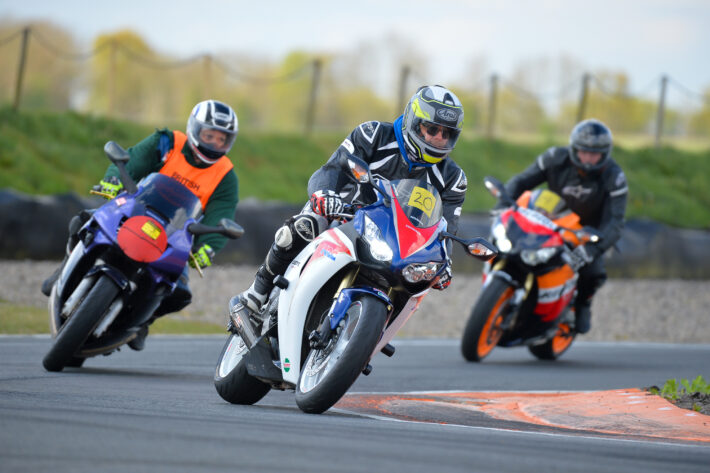
‘Loss of control’ is a serious issue however, contributing to at least 10 per cent of crashes, with ‘poor control’ leading to many other incidents according to riding expert Mike Abbott, who runs the British Superbike School.
The former automotive engineer with Ford – now with a long, illustrious career as a riding instructor on road and track – says that with care, confidence, training and above all experience, most loss of control moments can be avoided by motorcycle riders.
He says that the secret is learning how to put vital skills to avoid BTMs into practice early on, so that when trouble does strike, riders know instinctively how to react.
Mike, aged (70!), a RoSPA Advanced Motorcycle Instructor, DVSA Post-test trainer, ACU Road Race Coach and founder of the BSB, has now shared his inside tips with Devitt, so that you can stay safe too.
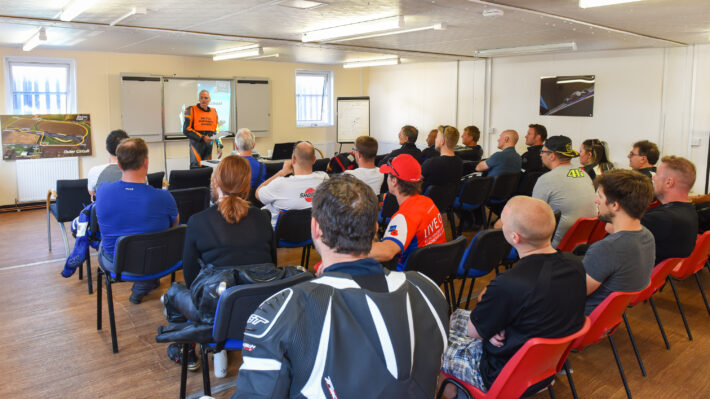
“Addressing the causes of loss of control, and training riders to control their machines better should not only make them more confident and enjoy their riding more, it should result in a reduction in road casualties,” says Mike, who has broken his advice down into four key areas covering acceleration, braking, changing gear and cornering.
ACCELERATION
CAUSE: Problems normally stem from the rear wheel losing grip, caused by a rider snatching the throttle or just using too much throttle. “The trick is to apply the throttle smoothly as with all controls – and open up smoothly as speed increases,” says Mike.
EFFECT: “If you do lose traction at the rear on a larger capacity bike the rear wheel will suddenly spin up, the bike will slew sideways and the rider instinctively snatches the throttle shut – and normally gets thrown up in the air,” says Mike.
WHY: MIke says that accelerating on a bend often causes particular problems because there is a trade-off between acceleration and cornering forces. “There is only so much grip available and it’s shared out between cornering and accelerating or braking. The steeper the angle of lean, the more steering grip you’re using and the less grip is available for acceleration or braking.”
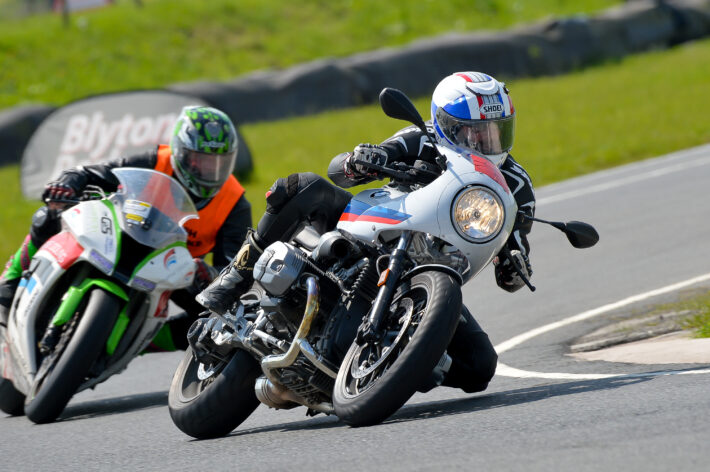
WHAT: “If you are thrown up in the air, you might land back in the seat but can end up going through the scenery,” says Mike. “Throttle control is a key skill that you have to work on – especially with a modern bike with all the power that’s at your disposal. Don’t think traction control will save you at extreme angles of lean – we know it won’t”.
ADVICE: “Loss of control, including when accelerating, can also be caused by poor road surfaces – the way around this is to make sure you recognise where the poor surface is and take care. It’s not always possible to see gravel on top of a road, so if in doubt the answer is to go steadily and keep the bike as upright as you can.”
BRAKING
Rear brake
CAUSE: You can lose control by braking too hard at the rear, causing the wheel to lock.
EFFECT: “When you first apply the brake the weight is evenly distributed between the front and rear tyres so as half of the weight is on the rear tyre, there’s plenty of grip there. Even if you don’t use the front brake, the weight is thrown forward and comes off the rear tyre. If you are using the front brake too, at the same time, this transfer takes place very much more quickly and the rear tyre can come right off the ground.”
WHY: At high speed, says Mike, you also have wind pressure on your chest, which keeps weight on the rear wheel but as you slow down that force diminishes so there’s more chance of the rear of the bike tipping up in the air – and the bike going sideways.
ADVICE: “It’s important, when using the rear brake to slow down, that you apply it quite hard at first then, as the bike slows, you need to release it to avoid locking the rear wheel with the chance of the bike going sideways,” says Mike.
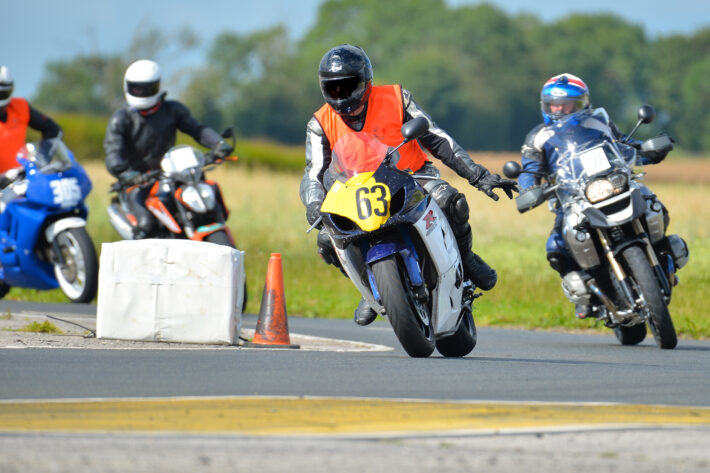
On a bend, with the rear brake, if you apply it mid corner it throws weight forwards, slows the bike down and allows the bike to turn faster, so that you can turn at a tighter radius.
It is useful, if you do get caught out mid-corner, and need to use a brake, to use the rear brake – it’s the safest way.
If you do lose traction at the back through treading too hard, release the brake; it should come back into line, and you should be heading in something like the same direction you were before.
Mike says that the other important aspect is to trail the rear brake into the corner. You leave the brake on as you turn into the corner.
As you lean, you need to reduce the pressure on the rear brake, gradually releasing it as the grip diminishes.
If you do find you’re going into a corner too fast and you’re uncomfortable, you can just keep the rear brake applied, then gradually ease it off and the bike will turn tighter and slower.
It’s having the presence of mind – or skill and experience – to do that.”
Front brake
CAUSE: You can also lose control by over-applying the front brake, says Mike. It’s snatching the brake that causes the problem, especially if you have a bike that hasn’t got an antilock braking system.
EFFECT: Modern brakes are so powerful that the front brake can instantly lock and the bike immediately goes to one side. If you can release the brake quickly the bike will – quite violently – spring back up and right itself due to the gyroscopic forces and the trail on the front suspension. Once again, if you stay in the seat you’re OK, and then you can apply the brakes again.
WHY: Lots of riders instinctively apply the brakes, feel the front of the bike start to slide and let off the brakes. The faster you let it off the less out of control you get.
ADVICE: “You really need to practice squeezing the brake at first, then you wait, only a second or so, for the weight to transfer forward,” says Mike. You can feel the back of the bike coming up and the front sinking down. When it stops sinking, you can pull on the lever as hard as you like. “You will not lock the front wheel provided you are upright and have a reasonable road surface. What prevents you braking any harder is that the rear wheel will leave the road.”
At that point, says Mike, you will have to let your brake off to avoid going over the handlebars (although that’s unlikely to happen) “It’s training riders to brake properly – squeezing it first, feeling for the bike to sink, then pulling hard on the brake – that counts,” adds Mike.
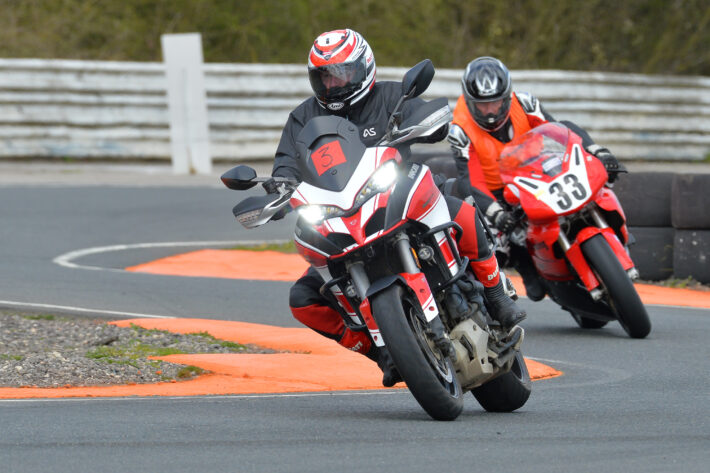
On a bend you can trail the front brake into the corner but the bike will want to go straight. The wheels go out of line with each other in a bend because of the geometry of the steering.
If you apply the front brake the wheels try to go into line again. So you have to hold the bike down.
If you go into a corner with the front brake applied it takes quite a bit of physical effort to counter steer the bike into the corner and then hold the bike with the steering angled into the corner against the braking forces, says Mike.
You have to release the brake as the lean angle increases or you will lose grip and the front will slide. If it does that, it’s very unlikely you’ll recover it. The bike will fall before you know what’s happened.
“Racers trail brake into a corner all the time. It does have some advantages; it keeps the weight on the front tyre which is doing all the steering.
It sharpens the geometry and it steers a bit quicker, but you do take the risk that you could lose traction and the bike could slide.
It’s not sensible to do it on a regular basis on the road but it’s a very useful thing to do if you’ve gone into a corner far too fast or you find an obstruction or hazard half way around that you need to slow down to avoid.”
CHANGING GEAR/USING THE CLUTCH
CAUSE: Changing down too soon can also cause loss of control.
EFFECT: If you change down too soon, the engine can’t ‘catch up’ with the rear wheel and the rear wheel can lock up, causing a skid, says Mike.
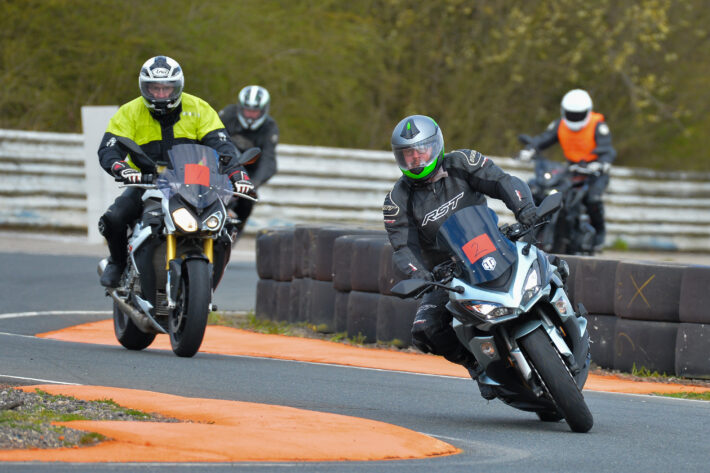
ADVICE: You can overcome this by timing gear changes better or by blipping the engine. You pull the clutch in, blip the engine, select a lower gear – and let the clutch out gently. “Older riders know how to do it because on old British bikes you were obliged to blip the throttle. You often don’t need to on modern bikes, but it does still require care and as you change down you do still need to let the clutch out nice and smoothly,” says Mike.
“You can also lose control from a standing start; if you accelerate too much, the front wheel can leave the tarmac. “Clearly, you are not in control with the front wheel in the air. I’ve seen a rider on a track day go over backwards at over 100mph on the main straight showing off. He was not in a good way. You do need to take care!”
CORNERING
CAUSE: Going into a bend too fast, possibly with, in Mike’s words, ‘everything scraping’.
EFFECT: The bike can run wide, placing you on the wrong side of the road.
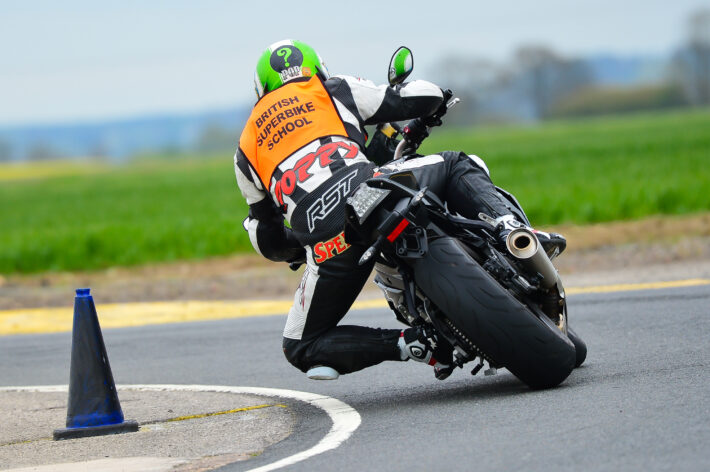
ADVICE: “For right hand corners you need to be over to the left for a better view around the corner, traffic and conditions permitting,” says Mike. Go in with the idea you can turn the bike harder and hit a late apex once you can see the corner is clear. Then you can straighten the bike and accelerate away. Go into a corner at a slower speed, with the aim of turning in tighter when you can see that the road ahead is clear. It’s better to go in wide and slow.
“There’s more grip on a decent road surface than most riders realise,” says Mike. “Also, bikes do not suddenly skit away, as long as you do things smoothly. They start to understeer or oversteer; you can feel the bike drifting sideways. Tyres are designed to have what’s called a ‘slip angle’. If you get near the limit, most tyres will start to drift. It’s like over or understeer on a car – it should not be unfamiliar to most riders.”
TECHNICAL ADVANCES
Mike says that technology has made a huge difference to the stability – and safety – of modern bikes. Frames, forks, suspension and tyres are all much better.
“Old British bikes used to get into ‘tank slappers’ – the handlebars would suddenly shake violently and the only way out was to accelerate; if you braked you got thrown off. That does not happen now.
“One of my early races was in the wet. I was braking at the 300 yard board at the end of Park Straight at Cadwell and other riders were still accelerating past me when I was braking. After following and copying them, I halved the braking distance. I got to the stage where I could get the back wheel into the air while braking on a soaking wet track, but it’s a matter of training and confidence.
“Antilock brakes are available now, front and rear, so if you snatch the front brake you still will not lock it. Quickshifters help too; you just push up and down and it changes gear for you. The problem of locking rear wheels is solved with slipper clutches that came from racing. If you let the clutch out too soon the clutch partially disengages itself.
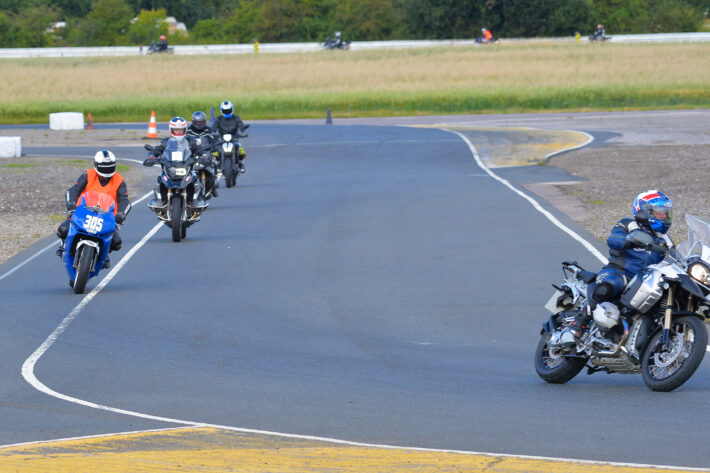
“Traction control helps too; if you accelerate too hard and the rear wheel starts to spin it will stop it immediately, and if you use too much throttle on lean, the computer on the bike will knock the throttle off to prevent the back wheel overtaking the front – but not necessarily at high lean angles.
“Some bikes have tilt sensors too. When weight is redistributed from front to back, as you brake or accelerate, if you brake too hard and the rear wheel comes off the deck, the system will release the front brake a little to let the rear wheel come down. Tilt sensors also prevent the front wheel coming up into the air if you accelerate too hard. This will prevent you either from going over the handlebars or flipping the bike over backwards.
“Cornering ABS has lean sensors. If you’re in a corner and use ABS the bike knows it’s leant over and reduces the amount of braking you can apply. It all helps.
“Nowadays the latest thing is adaptive suspension, so that the suspension adapts to the road conditions and you can pre programme it, so tyres spend more time in contact with the road. As these technological aids come through, we will see accidents reduce.
“But it is still important to understand what is happening to the bike, and how actions that you take affect the way the bike behaves. Riders need to work on their skills so that they are ready for anything – and instinctively know what to do. That can only come from training and experience.”
PUTTING IT ALL INTO PRACTICE
Mike invited me along to one of his Level II on-track motorcycle training days to learn how to put his safety theory into practice, with the British Superbike School, which he runs.
Based at the Blyton racetrack, in Lincolnshire, the day is divided into five different, carefully-structured on-track sections, each preceded by a classroom session, with riders divided into small groups, each with their own instructor.
During each classroom session – aided by diagrams and backed with safety advice – riders are encouraged to focus on one particular riding aspect in the ensuing lap, before packaging the tips together in the final ride of the day.
I signed up for a 117bhp Yamaha MT-09, pulled on my leathers, and climbed one of the grassy mounds to get a clear look at the track. It’s unusual, as it runs anti-clockwise.
The 1.6-mile circuit has nine distinct corners and loads of run-off, with minimal need for barriers. The surface is grippy and level.
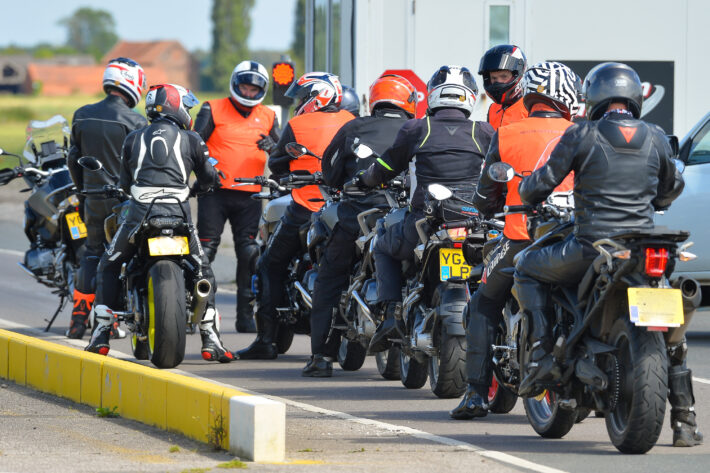
Heading to the classroom, Mike informed us that session 1 was for familiarisation. We would start off by following our instructor, taking it in turns to ride directly behind him, while we learned the lines.
Out on the circuit it was helpful to follow my instructor, especially after a long, enforced absence from riding in 2021 thanks to the loss of my parking space. The bike felt fast, the circuit relatively easily memorised – and directions from my instructor were clear.
For the rest of the day, the sessions focused on ‘judging entry speed and exit’ – apex to kerb’, followed by ‘mastering turning – turn-in point to apex’, ‘front brake control and weight transfer’, then ‘putting it all together’.
My confidence grew as – becoming more familiar with the ‘strange’ bike and previously unknown circuit – the day wore on. In between each ride, my instructor, Brett, critiqued my riding, dispensing invaluable advice and encouragement.
At each classroom session, Mike reiterated advice about how to ride safely, how to enter and exit bends, how best to brake and accelerate – even where to look. His depth of expertise – born of long experience in the saddle including extensive racing experience – shines through. His understanding of bike physics is deeply impressive, but simply explained.
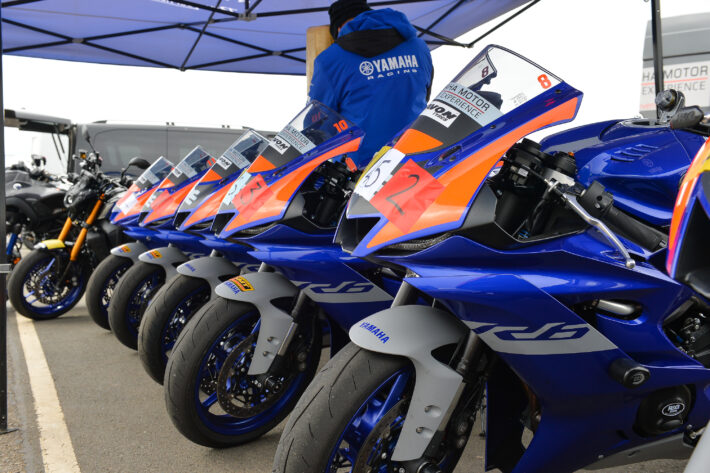
My riding was decidedly slow compared to my fellow motorcyclists in Level II, most of whom arrived on their own motorcycles, some delivered in vans, and with various approved racing mods and tyre warmers. I was soundly lapped on every circuit, but speeded up considerably as the day wore on, giving me ample opportunity to work on my cornering, braking and acceleration.
The great thing about an on-racetrack experience such as Mike’s – as opposed to a free-for-all track day – is that with abundant incisive expert advice, you feel able to experiment in ways you can’t on the road, leading to faster learning and improvement. And better riding – no matter where it’s learned – translates into better, safer riding on the road, too.
More information on the British Superbike School here: https://britishsuperbikeschool.com/
TAKE CARE!
Always ride within your own personal limits and stick to the rules of the road. If unsure about any of the advice in this article – or elsewhere – seek professional assistance and explanation before attempting to follow it, or putting it into practice. A great starting point is a police Bikesafe course. If in doubt, ask!
ONLINE
Mike delivered a talk on how to avoid loss of control accidents as part of Road Safety GB’s online PTW event, ‘PTW Riders: improving safety and reducing collisions and casualties’, sponsored by Devitt: https://roadsafetygb.org.uk/ptwevent/programme/
David Williams is a freelance journalist who specialises in road safety, transport and travel. He’s been the London Evening Standard’s motoring correspondent for 26 years, also contributing to the Daily and Sunday Telegraph, Sunday Times and various magazines. He is a Prince Michael of Kent International Road Safety Awards judge.
Twitter Handle – @djrwilliams

4 comments on “Loss of Control Bike Accidents – and How to Avoid Them”
First there is a mindful amount of information here. I am sure he knows his stuff but after a paragraph of two it seems very disjointed,m difficult for some to understand and over complicated. I have been riding for near on 60 years or so and still find it difficult to follow in this form.
It appears to me that Most if not all of the pictures relate to racing circuits and therefore one can presume that the basics of riding are relevant to the circuits and many may not relate to road riding as some of the teachings on track do not or should not relate to the road.
I would have thought that he would have concentrated on road riding as that is the most dangerous of situations where the vast majority of deaths and serious injuries take place but he waffled on and on about track practises etc. Do Devitt pay out more monies on road incidents or on track ones?.
I think that its more important to show inexperienced riders how to be safer on the road and not the track and to shown pictures of the road and its relative dangers rather than more specifics of racing bikes going fast round a track where there aren’t as many risks or dangers as their are on our roads.
So total confusion and unfortunately I think that many matters that will be disregarded as they are not considered by some to be applicable to the road riding demographic.
Dare I say that if you follow any advanced riding course based on Police Roadcraft then when it relates to bends and acceleration they have got it wrong. If you look at the picture of a bend in the Manual and the advice on how to ride it and when to accelerate they have it wrong.
They recommend acceleration when the bend is opening up and one can then accelerate. but looking at the picture the biker is actually still on the bend, in fact he is at the mid stage of one and one could say at the apex of the bend. That mid point. As such he is still only half way round the bend but his eyesight is many metres more ahead of him and following the limit point. He sees where the bend has opened up.
So if he then accelerates whilst still at the the apex and still has to lean the bike over to complete the bend and he accelerates at that mid point, i. too early he could run the risk of over acceleration, and lose the back end as described and high side, ie kicked off the bike. Oher wise if he accelerates too much he could lift up the front end and that reduces the amount of traction he has left on his front tyre and he loses the front end instead.
The only safe way of taking any bend is to enter at the correct speed and to maintain ones throttle and continue round that bend at a constant speed. That means that the bike will be at its most stable and should anything un towards happen one has a greater degree of control at ones fingertips to use in that emergence. Either counter steering or braking whatever.
Leave frontal trail braking for the track and just take more time, consideration and care when out on the country roads , That place that you share with other road users.
What little experience i have and ridden over 500,000 miles over my biking years,i have found that one needs to add power gently but progressively from apex out of the corner, add more if needed to help turn. Your control of throttle helps. Here in Ireland where roads a smaller in width, tighter bends quite a lot blind, check for the outside verge as to it either continues in same radius or closes, constant bend or tightens, road position keep left for right hand, right of middle for left hand.a gear if going to fast on approach. Look to where you want to go and bike should take you there. If following a bike that is ridden well and smooth he will soon be a few bends ahead. It is at this point you may want to take up some training.
Last sentence. If you are following a bike [r] that is ridden well?????? [who says so. and by what standard ] and is smooth [ nothing wrong with being smooth at all ] he will soon be a few bends ahead.
It is at this point you may want to take up some training.?, [Advert for track days I think]
However you might also think about ditching him and doing your own thing or finding a rider that suites your own skill set and of riding with safety in mind and not pushing the envelope of that safety.
Just a THOUGHT.